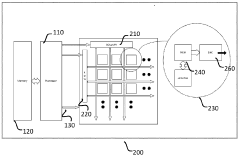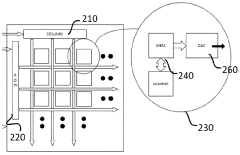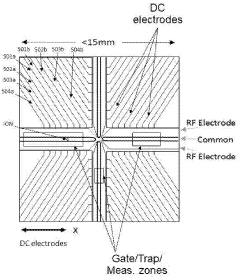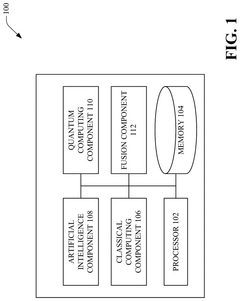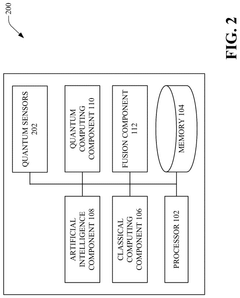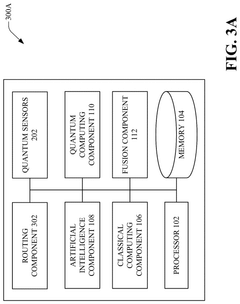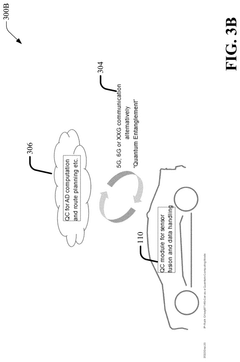Quantum Computing and its Role in Advanced Driver Assistance Systems
JUL 17, 20259 MIN READ
Generate Your Research Report Instantly with AI Agent
Patsnap Eureka helps you evaluate technical feasibility & market potential.
Quantum Computing in ADAS: Background and Objectives
Quantum computing represents a paradigm shift in computational capabilities, leveraging the principles of quantum mechanics to perform complex calculations at unprecedented speeds. In the context of Advanced Driver Assistance Systems (ADAS), quantum computing holds the potential to revolutionize the way vehicles perceive, process, and respond to their environment. The evolution of ADAS has been marked by incremental improvements in sensor technology, data processing, and decision-making algorithms. However, the integration of quantum computing promises to catapult these systems into a new era of performance and reliability.
The primary objective of exploring quantum computing in ADAS is to overcome the current limitations of classical computing systems in handling the vast amounts of data generated by autonomous vehicles. As vehicles become more connected and autonomous, the need for real-time processing of complex scenarios becomes increasingly critical. Quantum computing's ability to perform parallel computations and solve optimization problems could significantly enhance the decision-making capabilities of ADAS, particularly in areas such as route optimization, traffic flow prediction, and object recognition.
The technological trajectory of quantum computing in ADAS is closely aligned with the broader advancements in quantum hardware and algorithms. Early-stage research focuses on developing quantum algorithms that can outperform classical algorithms in specific ADAS-related tasks. These include quantum machine learning techniques for improved pattern recognition in sensor data and quantum optimization algorithms for more efficient route planning.
As the field progresses, we anticipate the development of hybrid quantum-classical systems that can leverage the strengths of both computing paradigms. This approach allows for the gradual integration of quantum capabilities into existing ADAS architectures, providing a practical pathway for adoption in the automotive industry. The long-term vision involves fully quantum-enabled ADAS that can process and analyze vast amounts of data in real-time, making split-second decisions with a level of accuracy and reliability that surpasses current systems.
The potential impact of quantum computing on ADAS extends beyond performance enhancements. It also opens up possibilities for new features and functionalities that were previously unfeasible due to computational limitations. For instance, quantum-enabled ADAS could potentially simulate complex traffic scenarios in real-time, allowing vehicles to anticipate and respond to potential hazards before they materialize. This proactive approach to safety could significantly reduce accident rates and improve overall traffic efficiency.
The primary objective of exploring quantum computing in ADAS is to overcome the current limitations of classical computing systems in handling the vast amounts of data generated by autonomous vehicles. As vehicles become more connected and autonomous, the need for real-time processing of complex scenarios becomes increasingly critical. Quantum computing's ability to perform parallel computations and solve optimization problems could significantly enhance the decision-making capabilities of ADAS, particularly in areas such as route optimization, traffic flow prediction, and object recognition.
The technological trajectory of quantum computing in ADAS is closely aligned with the broader advancements in quantum hardware and algorithms. Early-stage research focuses on developing quantum algorithms that can outperform classical algorithms in specific ADAS-related tasks. These include quantum machine learning techniques for improved pattern recognition in sensor data and quantum optimization algorithms for more efficient route planning.
As the field progresses, we anticipate the development of hybrid quantum-classical systems that can leverage the strengths of both computing paradigms. This approach allows for the gradual integration of quantum capabilities into existing ADAS architectures, providing a practical pathway for adoption in the automotive industry. The long-term vision involves fully quantum-enabled ADAS that can process and analyze vast amounts of data in real-time, making split-second decisions with a level of accuracy and reliability that surpasses current systems.
The potential impact of quantum computing on ADAS extends beyond performance enhancements. It also opens up possibilities for new features and functionalities that were previously unfeasible due to computational limitations. For instance, quantum-enabled ADAS could potentially simulate complex traffic scenarios in real-time, allowing vehicles to anticipate and respond to potential hazards before they materialize. This proactive approach to safety could significantly reduce accident rates and improve overall traffic efficiency.
Market Analysis for Quantum-Enhanced ADAS
The market for quantum-enhanced Advanced Driver Assistance Systems (ADAS) is poised for significant growth in the coming years. As automotive technologies continue to evolve, the integration of quantum computing into ADAS presents a promising avenue for enhancing vehicle safety, efficiency, and autonomy. The current ADAS market is already substantial, with global revenues expected to reach $74 billion by 2030. However, the introduction of quantum-enhanced solutions could potentially accelerate this growth and reshape the competitive landscape.
Quantum computing's ability to process complex algorithms and vast amounts of data in real-time makes it particularly well-suited for ADAS applications. This technology could dramatically improve the performance of key ADAS functions such as object detection, path planning, and decision-making under uncertainty. As a result, the demand for quantum-enhanced ADAS is likely to emerge first in premium vehicle segments, where consumers are willing to pay for cutting-edge safety and convenience features.
The market potential for quantum-enhanced ADAS extends beyond personal vehicles. Commercial fleets, including long-haul trucks and delivery vehicles, stand to benefit significantly from the improved efficiency and safety that quantum-powered systems could provide. This sector could drive early adoption and help scale the technology, potentially leading to more widespread implementation across the automotive industry.
Geographically, North America and Europe are expected to lead in the adoption of quantum-enhanced ADAS, given their strong automotive industries and investments in quantum technologies. However, Asian markets, particularly China and Japan, are likely to follow closely behind, driven by their robust automotive manufacturing sectors and government support for advanced technologies.
The integration of quantum computing into ADAS is not without challenges. The high cost of quantum hardware, the need for specialized expertise, and the current limitations of quantum technologies present significant barriers to widespread adoption. However, as quantum technologies mature and become more accessible, these obstacles are expected to diminish, opening up broader market opportunities.
Partnerships between automotive manufacturers, technology companies, and quantum computing specialists will be crucial in driving the development and commercialization of quantum-enhanced ADAS. These collaborations will not only accelerate innovation but also help in addressing the complex technical and regulatory challenges associated with deploying quantum technologies in safety-critical automotive systems.
As the market for quantum-enhanced ADAS evolves, it is likely to create new revenue streams and business models within the automotive and technology sectors. This could include subscription-based services for advanced ADAS features, data monetization opportunities, and the emergence of specialized quantum-ADAS software and hardware providers.
Quantum computing's ability to process complex algorithms and vast amounts of data in real-time makes it particularly well-suited for ADAS applications. This technology could dramatically improve the performance of key ADAS functions such as object detection, path planning, and decision-making under uncertainty. As a result, the demand for quantum-enhanced ADAS is likely to emerge first in premium vehicle segments, where consumers are willing to pay for cutting-edge safety and convenience features.
The market potential for quantum-enhanced ADAS extends beyond personal vehicles. Commercial fleets, including long-haul trucks and delivery vehicles, stand to benefit significantly from the improved efficiency and safety that quantum-powered systems could provide. This sector could drive early adoption and help scale the technology, potentially leading to more widespread implementation across the automotive industry.
Geographically, North America and Europe are expected to lead in the adoption of quantum-enhanced ADAS, given their strong automotive industries and investments in quantum technologies. However, Asian markets, particularly China and Japan, are likely to follow closely behind, driven by their robust automotive manufacturing sectors and government support for advanced technologies.
The integration of quantum computing into ADAS is not without challenges. The high cost of quantum hardware, the need for specialized expertise, and the current limitations of quantum technologies present significant barriers to widespread adoption. However, as quantum technologies mature and become more accessible, these obstacles are expected to diminish, opening up broader market opportunities.
Partnerships between automotive manufacturers, technology companies, and quantum computing specialists will be crucial in driving the development and commercialization of quantum-enhanced ADAS. These collaborations will not only accelerate innovation but also help in addressing the complex technical and regulatory challenges associated with deploying quantum technologies in safety-critical automotive systems.
As the market for quantum-enhanced ADAS evolves, it is likely to create new revenue streams and business models within the automotive and technology sectors. This could include subscription-based services for advanced ADAS features, data monetization opportunities, and the emergence of specialized quantum-ADAS software and hardware providers.
Current Challenges in Quantum Computing for Automotive
Quantum computing presents several significant challenges when applied to the automotive industry, particularly in the context of Advanced Driver Assistance Systems (ADAS). One of the primary obstacles is the current limitation in qubit stability and coherence time. While quantum computers have shown promise in solving complex problems, maintaining quantum states for extended periods remains a significant hurdle. This instability can lead to errors in computations, which is particularly problematic for safety-critical applications like ADAS.
Another challenge lies in the scalability of quantum systems. Current quantum computers are limited in the number of qubits they can effectively manage, which restricts their ability to handle the vast amounts of data required for real-time ADAS operations. The automotive industry demands robust, reliable systems that can process information from multiple sensors simultaneously, a task that current quantum computers are not yet equipped to handle consistently.
The integration of quantum computing with classical computing systems poses another significant challenge. ADAS relies on a combination of various technologies, and seamlessly incorporating quantum algorithms into existing classical systems requires substantial research and development. This integration is crucial for leveraging the potential benefits of quantum computing in automotive applications without compromising the reliability of current systems.
Environmental factors also present a considerable challenge. Quantum computers typically require extremely low temperatures and highly controlled environments to function properly. Adapting these sensitive systems to operate reliably in the diverse and often harsh conditions experienced by vehicles is a formidable task. Temperature fluctuations, vibrations, and electromagnetic interference in automotive environments can significantly impact the performance of quantum systems.
Moreover, the development of quantum algorithms specifically tailored for ADAS applications is still in its infancy. While quantum computing shows promise in optimization problems, which could benefit route planning and traffic management, creating efficient quantum algorithms for tasks such as object detection, lane keeping, and collision avoidance remains a complex challenge. These algorithms need to be not only effective but also capable of operating within the constraints of current quantum hardware.
Lastly, the cost and accessibility of quantum computing technology present significant barriers to widespread adoption in the automotive industry. The development and maintenance of quantum systems require substantial investment, specialized expertise, and infrastructure that are not readily available to many automotive manufacturers. This economic challenge slows down the integration of quantum computing into ADAS and limits its potential benefits to high-end vehicles, at least in the near term.
Another challenge lies in the scalability of quantum systems. Current quantum computers are limited in the number of qubits they can effectively manage, which restricts their ability to handle the vast amounts of data required for real-time ADAS operations. The automotive industry demands robust, reliable systems that can process information from multiple sensors simultaneously, a task that current quantum computers are not yet equipped to handle consistently.
The integration of quantum computing with classical computing systems poses another significant challenge. ADAS relies on a combination of various technologies, and seamlessly incorporating quantum algorithms into existing classical systems requires substantial research and development. This integration is crucial for leveraging the potential benefits of quantum computing in automotive applications without compromising the reliability of current systems.
Environmental factors also present a considerable challenge. Quantum computers typically require extremely low temperatures and highly controlled environments to function properly. Adapting these sensitive systems to operate reliably in the diverse and often harsh conditions experienced by vehicles is a formidable task. Temperature fluctuations, vibrations, and electromagnetic interference in automotive environments can significantly impact the performance of quantum systems.
Moreover, the development of quantum algorithms specifically tailored for ADAS applications is still in its infancy. While quantum computing shows promise in optimization problems, which could benefit route planning and traffic management, creating efficient quantum algorithms for tasks such as object detection, lane keeping, and collision avoidance remains a complex challenge. These algorithms need to be not only effective but also capable of operating within the constraints of current quantum hardware.
Lastly, the cost and accessibility of quantum computing technology present significant barriers to widespread adoption in the automotive industry. The development and maintenance of quantum systems require substantial investment, specialized expertise, and infrastructure that are not readily available to many automotive manufacturers. This economic challenge slows down the integration of quantum computing into ADAS and limits its potential benefits to high-end vehicles, at least in the near term.
Existing Quantum Solutions for ADAS Applications
01 Quantum computing architectures
This category focuses on the design and implementation of quantum computing systems. It includes innovations in qubit arrangements, circuit layouts, and overall system architectures to improve quantum computation efficiency and scalability.- Quantum computing architectures: This category focuses on the design and implementation of quantum computing systems. It includes innovations in qubit arrangements, circuit layouts, and overall system architectures to improve quantum computation efficiency and scalability.
- Error correction and fault tolerance: This area addresses the challenges of maintaining quantum coherence and mitigating errors in quantum systems. It involves techniques for error detection, correction, and fault-tolerant quantum computation to enhance the reliability of quantum operations.
- Quantum algorithms and applications: This category covers the development of quantum algorithms for various computational problems and their practical applications. It includes innovations in quantum simulation, optimization, machine learning, and cryptography that leverage the unique properties of quantum systems.
- Quantum-classical hybrid systems: This area focuses on integrating quantum and classical computing technologies to create hybrid systems. It includes methods for interfacing quantum processors with classical hardware, optimizing resource allocation, and developing algorithms that leverage both quantum and classical components.
- Quantum hardware and control systems: This category encompasses innovations in quantum hardware components and control systems. It includes advancements in qubit technologies, quantum gates, readout mechanisms, and control electronics to improve the performance and reliability of quantum computing systems.
02 Error correction and fault tolerance
This area addresses the challenges of maintaining quantum coherence and mitigating errors in quantum systems. It involves developing algorithms and techniques for error detection, correction, and fault-tolerant quantum computation to improve the reliability of quantum computers.Expand Specific Solutions03 Quantum algorithms and applications
This category encompasses the development of quantum algorithms for various applications, including optimization, simulation, and cryptography. It also covers the integration of quantum computing with classical systems for hybrid quantum-classical algorithms.Expand Specific Solutions04 Quantum hardware and qubit technologies
This area focuses on the physical implementation of qubits and quantum hardware. It includes advancements in superconducting circuits, trapped ions, photonics, and other qubit technologies, as well as improvements in quantum gate operations and readout mechanisms.Expand Specific Solutions05 Quantum control and measurement
This category deals with techniques for precise control and measurement of quantum states. It includes innovations in quantum state preparation, manipulation, and readout, as well as advancements in quantum sensing and metrology applications.Expand Specific Solutions
Key Players in Quantum Computing and ADAS Industries
The quantum computing landscape in Advanced Driver Assistance Systems (ADAS) is in its early stages, with significant potential for growth. The market is poised for expansion as automotive companies and tech giants explore quantum applications in ADAS. Companies like Google, IBM, and D-Wave are leading in quantum technology development, while automotive manufacturers such as Ford, Volvo, and BMW are investigating its potential in ADAS. The technology is still in the research and development phase, with limited commercial applications. However, collaborations between quantum computing firms and automotive companies are increasing, indicating a growing interest in leveraging quantum capabilities for complex ADAS challenges like real-time decision-making and route optimization.
Google LLC
Technical Solution: Google's approach to quantum computing in ADAS focuses on developing quantum algorithms for complex optimization problems in route planning and traffic management. They are working on a quantum-enhanced neural network architecture that can process vast amounts of sensor data more efficiently than classical systems[1]. Google's Sycamore quantum processor has demonstrated quantum supremacy, performing a specific task in 200 seconds that would take a classical supercomputer 10,000 years[2]. For ADAS applications, Google is exploring quantum machine learning techniques to improve object detection and prediction accuracy in autonomous vehicles.
Strengths: Cutting-edge quantum hardware and software integration, vast computational resources, and expertise in AI. Weaknesses: Quantum systems still require extreme cooling, limiting in-vehicle applications.
Ford Global Technologies LLC
Technical Solution: Ford is investigating quantum computing applications in ADAS, focusing on optimizing vehicle routing and traffic flow prediction. They are developing quantum algorithms for real-time decision-making in autonomous vehicles, potentially reducing latency in critical safety systems[3]. Ford's approach includes quantum-inspired algorithms for battery chemistry simulations, which could lead to improved electric vehicle performance in autonomous systems. The company is also exploring quantum sensing technologies for enhanced LiDAR and radar systems, aiming to improve object detection and ranging accuracy in various weather conditions[4].
Strengths: Deep automotive industry knowledge, existing ADAS infrastructure, and partnerships with quantum technology providers. Weaknesses: Limited in-house quantum computing expertise compared to tech giants.
Core Quantum Algorithms for ADAS Optimization
Quantum computing system and methods thereof
PatentPendingGB2602003A
Innovation
- A distributed architecture where each electrode driver circuit has a local processor and memory, allowing asynchronous receipt of waveform commands from a central controller, decoupling the central processor from DACs and enabling local processing and memory for each electrode, thus reducing noise and enhancing scalability.
Fusion of classical computing, artificial intelligence or quantum computing for vehicle operation
PatentPendingUS20250115270A1
Innovation
- The integration of classical computing, artificial intelligence, and quantum computing through a fusion component that dynamically engages one or more of these components based on computational intensity, enabling enhanced decision-making, improved data processing, and robust security measures.
Regulatory Framework for Quantum-Enhanced Automotive Systems
As quantum computing technology continues to advance and find applications in various industries, the automotive sector is poised to benefit significantly from its integration into Advanced Driver Assistance Systems (ADAS). However, the implementation of quantum-enhanced automotive systems raises important regulatory considerations that must be addressed to ensure safety, security, and ethical use of this powerful technology.
The regulatory framework for quantum-enhanced automotive systems must first establish clear guidelines for the development, testing, and deployment of quantum-powered ADAS. This includes defining safety standards and performance metrics specific to quantum computing applications in vehicles. Regulatory bodies will need to work closely with automotive manufacturers, technology providers, and cybersecurity experts to create comprehensive protocols for validating the reliability and robustness of quantum-enhanced systems.
Data privacy and security regulations will play a crucial role in the governance of quantum-enhanced automotive systems. As quantum computers have the potential to process vast amounts of sensitive information, including real-time vehicle data and personal user information, stringent measures must be put in place to protect against data breaches and unauthorized access. Regulations should outline specific encryption requirements and data handling protocols tailored to the unique capabilities and vulnerabilities of quantum systems.
The ethical implications of quantum-enhanced ADAS must also be addressed within the regulatory framework. This includes establishing guidelines for the responsible use of quantum computing in decision-making processes, particularly in scenarios involving potential accidents or conflicts between vehicle safety and pedestrian safety. Regulations should define the boundaries of autonomous decision-making and ensure that human oversight remains a critical component of these systems.
Interoperability and standardization will be key aspects of the regulatory framework. As quantum-enhanced automotive systems become more prevalent, it will be essential to establish industry-wide standards for communication protocols, data formats, and system interfaces. This will facilitate seamless integration between different vehicles and infrastructure components, ensuring a cohesive and efficient transportation ecosystem.
Liability and insurance considerations must also be addressed within the regulatory framework. As quantum-enhanced ADAS become more sophisticated and autonomous, questions of responsibility in the event of accidents or system failures will become increasingly complex. Regulations should clearly define the legal responsibilities of manufacturers, software providers, and vehicle owners, and establish guidelines for insurance coverage in this new technological landscape.
Finally, the regulatory framework must be adaptable and forward-looking, capable of evolving alongside rapid advancements in quantum computing technology. Regular reviews and updates to the regulations should be mandated to ensure they remain relevant and effective in addressing emerging challenges and opportunities in the field of quantum-enhanced automotive systems.
The regulatory framework for quantum-enhanced automotive systems must first establish clear guidelines for the development, testing, and deployment of quantum-powered ADAS. This includes defining safety standards and performance metrics specific to quantum computing applications in vehicles. Regulatory bodies will need to work closely with automotive manufacturers, technology providers, and cybersecurity experts to create comprehensive protocols for validating the reliability and robustness of quantum-enhanced systems.
Data privacy and security regulations will play a crucial role in the governance of quantum-enhanced automotive systems. As quantum computers have the potential to process vast amounts of sensitive information, including real-time vehicle data and personal user information, stringent measures must be put in place to protect against data breaches and unauthorized access. Regulations should outline specific encryption requirements and data handling protocols tailored to the unique capabilities and vulnerabilities of quantum systems.
The ethical implications of quantum-enhanced ADAS must also be addressed within the regulatory framework. This includes establishing guidelines for the responsible use of quantum computing in decision-making processes, particularly in scenarios involving potential accidents or conflicts between vehicle safety and pedestrian safety. Regulations should define the boundaries of autonomous decision-making and ensure that human oversight remains a critical component of these systems.
Interoperability and standardization will be key aspects of the regulatory framework. As quantum-enhanced automotive systems become more prevalent, it will be essential to establish industry-wide standards for communication protocols, data formats, and system interfaces. This will facilitate seamless integration between different vehicles and infrastructure components, ensuring a cohesive and efficient transportation ecosystem.
Liability and insurance considerations must also be addressed within the regulatory framework. As quantum-enhanced ADAS become more sophisticated and autonomous, questions of responsibility in the event of accidents or system failures will become increasingly complex. Regulations should clearly define the legal responsibilities of manufacturers, software providers, and vehicle owners, and establish guidelines for insurance coverage in this new technological landscape.
Finally, the regulatory framework must be adaptable and forward-looking, capable of evolving alongside rapid advancements in quantum computing technology. Regular reviews and updates to the regulations should be mandated to ensure they remain relevant and effective in addressing emerging challenges and opportunities in the field of quantum-enhanced automotive systems.
Quantum Computing Security Implications for ADAS
The integration of quantum computing into Advanced Driver Assistance Systems (ADAS) presents significant security implications that must be carefully considered. As quantum computers become more powerful, they pose potential threats to traditional cryptographic systems used in ADAS, potentially compromising the safety and privacy of connected vehicles.
One of the primary concerns is the vulnerability of current public-key cryptography algorithms to quantum attacks. Many ADAS systems rely on these algorithms for secure communication and data protection. Quantum computers, with their ability to solve certain mathematical problems exponentially faster than classical computers, could potentially break these encryption methods, exposing sensitive vehicle data and control systems to malicious actors.
To address this challenge, the automotive industry must invest in quantum-resistant cryptography, also known as post-quantum cryptography. These new encryption methods are designed to withstand attacks from both classical and quantum computers. Implementing quantum-resistant algorithms in ADAS will be crucial to maintain the integrity and confidentiality of vehicle communications, sensor data, and control systems.
Another security implication is the potential for quantum-enhanced attacks on machine learning models used in ADAS. Quantum algorithms could potentially accelerate the process of finding adversarial examples or exploiting vulnerabilities in AI systems, potentially compromising the reliability of autonomous driving features. To mitigate this risk, researchers must develop quantum-resistant machine learning techniques and robust validation processes for ADAS algorithms.
Quantum computing also introduces new challenges in securing over-the-air updates for ADAS systems. As vehicles become more connected and reliant on software updates, ensuring the authenticity and integrity of these updates becomes paramount. Quantum-resistant digital signatures and secure key distribution mechanisms will be essential to prevent unauthorized modifications to critical ADAS components.
Furthermore, the advent of quantum sensing technologies may require a reassessment of ADAS sensor security. Quantum sensors could potentially detect and manipulate classical sensors used in ADAS, necessitating the development of quantum-safe sensor technologies and data validation methods to ensure the accuracy and reliability of environmental perception systems.
As quantum computing advances, it is crucial for automotive manufacturers and ADAS developers to collaborate with cybersecurity experts and quantum computing specialists to stay ahead of potential threats. This collaboration should focus on developing comprehensive security frameworks that address quantum vulnerabilities, implement quantum-resistant cryptography, and establish rigorous testing protocols for quantum-safe ADAS components.
One of the primary concerns is the vulnerability of current public-key cryptography algorithms to quantum attacks. Many ADAS systems rely on these algorithms for secure communication and data protection. Quantum computers, with their ability to solve certain mathematical problems exponentially faster than classical computers, could potentially break these encryption methods, exposing sensitive vehicle data and control systems to malicious actors.
To address this challenge, the automotive industry must invest in quantum-resistant cryptography, also known as post-quantum cryptography. These new encryption methods are designed to withstand attacks from both classical and quantum computers. Implementing quantum-resistant algorithms in ADAS will be crucial to maintain the integrity and confidentiality of vehicle communications, sensor data, and control systems.
Another security implication is the potential for quantum-enhanced attacks on machine learning models used in ADAS. Quantum algorithms could potentially accelerate the process of finding adversarial examples or exploiting vulnerabilities in AI systems, potentially compromising the reliability of autonomous driving features. To mitigate this risk, researchers must develop quantum-resistant machine learning techniques and robust validation processes for ADAS algorithms.
Quantum computing also introduces new challenges in securing over-the-air updates for ADAS systems. As vehicles become more connected and reliant on software updates, ensuring the authenticity and integrity of these updates becomes paramount. Quantum-resistant digital signatures and secure key distribution mechanisms will be essential to prevent unauthorized modifications to critical ADAS components.
Furthermore, the advent of quantum sensing technologies may require a reassessment of ADAS sensor security. Quantum sensors could potentially detect and manipulate classical sensors used in ADAS, necessitating the development of quantum-safe sensor technologies and data validation methods to ensure the accuracy and reliability of environmental perception systems.
As quantum computing advances, it is crucial for automotive manufacturers and ADAS developers to collaborate with cybersecurity experts and quantum computing specialists to stay ahead of potential threats. This collaboration should focus on developing comprehensive security frameworks that address quantum vulnerabilities, implement quantum-resistant cryptography, and establish rigorous testing protocols for quantum-safe ADAS components.
Unlock deeper insights with Patsnap Eureka Quick Research — get a full tech report to explore trends and direct your research. Try now!
Generate Your Research Report Instantly with AI Agent
Supercharge your innovation with Patsnap Eureka AI Agent Platform!

